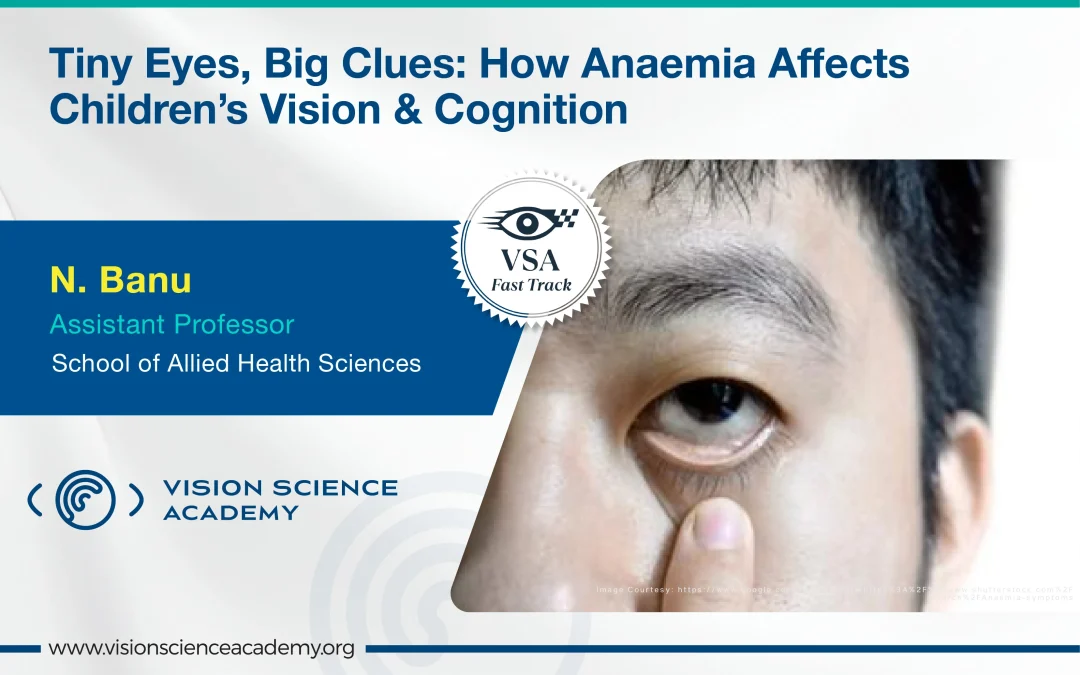N. Banu, M.Optom.
Assistant Professor, School of Allied Health Sciences, Chennai, India
Anaemia is a condition marked by a decrease in the number of red blood cells or a reduction in Haemoglobin concentration, resulting in a diminished ability to transport oxygen throughout the body. (1,2)
Haemoglobin, a metalloprotein composed of four subunits, has an iron-bound heme group that enables it to bind and transport oxygen from the lungs to the tissues. (3) Each Haemoglobin molecule can carry four oxygen molecules, as one oxygen molecule binds to each iron atom in the heme group. When there are structural defects or issues with the synthesis of red blood cells (erythrocytes), the capacity of Haemoglobin to carry oxygen can be impaired, leading to hypoxia. (4)
Hypoxia can result in compromised tissue function, particularly noticeable in the muscular, cardiovascular, and central nervous systems, which can manifest as Anaemia. (5) According to the World Health Organisation (WHO), Anaemia affects approximately 24.8% of the global population, equating to about 1.62 billion people. The highest prevalence is seen in preschool children at 47.4% and 25.4% among school-aged children. (6)
Anaemia and Its Impact on the Eyes
Anaemia can lead to various ocular disorders, including retinopathy, optic neuropathy, and loss of visual function, as well as affecting eye movements. In individuals with Anaemia, associations have been found between iron deficiency Anaemia and measures of ocular health, such as the central cornea thickness and retinal nerve fibre layer thickness. (7) Additionally, Anaemia has been shown to impact the binocular vision status of children. (8)
Anaemia and Non-Strabismic Binocular Vision Anomalies
In children with Anaemia, binocular functions may be affected, leading to non-strabismic binocular vision anomalies. (8) Effective binocular vision, without symptoms, relies on three key components: the anatomical structure of the visual system, the motor system that coordinates eye movements, and the sensory system through which the brain receives and integrates the two monocular signals. (9) Any anomalies in binocular vision can result in asthenopic symptoms, which may lead to discomfort and visual fatigue. (10)
Anaemia and Cognition
Anaemia impacts cognitive function through both direct neurochemical effects and indirect behavioral influences. (11) The direct neurochemical effects stem from disruptions in normal oxidative metabolism in the brain due to Anaemia, which can impair cognitive abilities. (12) Additionally, iron deficiency Anaemia negatively affects cognition through various pathways. Cognition encompasses the processing of information, the acquisition of knowledge, and the understanding of sensory inputs. It includes functions such as perception, attention, sustained concentration, memory, visual and spatial processing, language skills, problem-solving, decision-making, and sequencing. (13)
Conclusion
Iron is essential for brain function; thus, a decrease in iron concentration in the brain can lead to lower levels of neurotransmitters like epinephrine and dopamine, which are crucial for cognitive function. (14)
This illustrates how Anaemia can influence the eye’s binocular status by affecting dopamine levels in the brain, subsequently leading to conditions like convergence insufficiency. Early diagnosis and intervention can help address these deficiencies, ensure comfortable binocular vision, and improve academic performance.
References
- Terri D. Johnson-Wimbley, David Y. Graham; Diagnosis and management of iron deficiency Anaemia in the 21st century.; 2011
- Roland N. Pittman. San Rafael; Regulation of Tissue Oxygenation: oxygen transport in blood; Morgan & Claypool Life Sciences; 2011.
- Rowe AJ Marengo; Structure function relations of human Haemoglobins; 2006 Jul 19 (3):239-45.
- Carl E. Rhodes1; Matthew Varacallo2; Physiology, Oxygen Transport; 2019, StatPearls [Internet]. Treasure Island (FL): StatPearls Publishing; 2025 Jan.2022 Nov 14.PMID: 30855920, Bookshelf ID: NBK538336
- Gaurav, Y. Shah, and Modi Rohit; Anemic retinopathy: case reports and disease features. Clinical findings vary depending on the etiology of the Anaemia.;2016
- De Benoist B et al., Worldwide prevalence of Anaemia 1993-2005.WHO Global Database on Anaemia, Geneva, World Health Organisation, 2008.
- J Venkatramani, P Mitchell; Ocular and systemic causes of retinopathy in patients without diabetes mellitus. BMJ 2004; 328: 625-9.
- Alrasheed SH, Amir R, Ali T, Alkhaleeg ZA; The impact of childhood Anaemia on binocular functions. Sudanese J Ophthalmology 2017; 9: 57-61.
- BJ Evans; Pickwell’s binocular vision anomalies: Investigation and treatment. 5th ed. London: Elsevier Health Sciences; 2007.
- ML Mazow; The convergence insufficiency syndrome. JPediatrOphthalmol Strabismus. 1971; 8: 243–244.
- Ranjan Anuja, Y. Jyothi, Kuntal Das, Angel Mary; Effects of Anaemia on Cognitive Function; Journal of Pharmaceutical Research Volume 16, Issue 2, Apr – Jun, 2017: 134
- Raj C Shah 1, Robert S Wilson, Yuxiao Tang, Xinqi Dong, Anne Murray, David A Bennett Relation of Haemoglobin to level of cognitive function in older persons
- Affiliations Expand,PMID: 1900179,PMCID: PMC2739739, DOI: 10.1159/000170905
- Michelon D. What are Cognitive Abilities and Skills, and How to Boost Them? Sharp Brains. 2017; 5 January 2017.
- E Pollitt. Iron deficiency and cognitive function. Annual Review of Nutrition. 1993; 13: 521–537.


Recent Comments